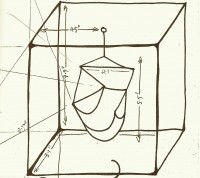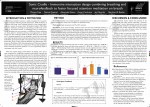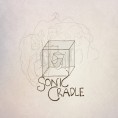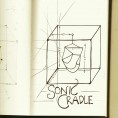
Sonic Cradle suspends the body is a completely dark chamber which encourages experiences comparable to mindfulness meditation. Users compose peaceful soundscapes in real-time using only their breathing.
Introduction and demo of the Sonic Cradle
Sonic Cradle is a relaxing human-computer interaction paradigm designed to foster meditative attentional patterns. The current prototype is a darkened chamber which suspends individuals in a comfortable hammock while they progressively control sound through their own respiration. 15 co-design sessions resulted in several tweaks and improvements aimed at balancing users’ perceived sense of control.
A mixed methods investigation of the iterated prototype with a purposive sample of 39 participants demonstrated how Sonic Cradle can pleasantly encourage mindful experiences by consistently inducing a calm mental clarity and loss of intention. Surprisingly, participants also reported perceptual illusions, feelings of floating, and emotional responses. This project breaks new ground toward fulfilling technology’s potential to experientially persuade people to adopt and psychologically benefit from contemplative practices like mindfulness meditation.
Jay Vidyarthi presenting the Sonic Cradle as part of his thesis defense.
Alex Kitson presenting her paper on “Sonic Cradle: Investigating Meditative Aspects of an Interactive Technology” at the 2014 GRAND conference in Ottawa
Sonic Cradle is an interactive system designed to encourage a meditative attentional pattern akin to mindfulness. Users are comfortably suspended in a dark chamber where they use respiration as a means to focus and control an immersive soundscape. Basic interpretive qualitative methods along with three quantitative scales, Affect Grid, Toronto Mindfulness Scale, and State-Trait Anxiety Inventory, that assess mood, mindfulness, and anxiety, respectively, were used to analyze data of 30 participants after 15-minute sessions of both Sonic Cradle and self– guided relaxation. This talk is part of a larger study and will only discuss the Toronto Mindfulness Scale. Results suggest that Sonic Cradle may help to induce a mindfulness-like state and offers a unique experience compared to simply trying to relax in a dark room without any assistance. With mounting evidence implying mindfulness meditation as an effective practice for self-regulation, our results are promising that Sonic Cradle can be an effective tool in cultivating and increasing psychological well-being. Moreover, Sonic Cradle can be instrumental in introducing mindfulness to non-meditators or those who are unable to learn mindfulness through more traditional means.
More...
» Listen to sound recordings of the Sonic Cradle in use
» Watch a video demo of the Sonic Cradle artifact
Recent extensions of the Sonic Cradle using Neurofeedback
While the original Sonic Cradle design proved effective by helping users reach a state comparable to mindfulness meditation, participants reported that the soundscape occasionally distracted them from breathing mindfully. To address this, we are integrating EEG data from the Interaxon Muse head-set to detect when users have achieved a state of focused attention, and gradually reduce the soundscape inconspicuously. Conversely, when EEG data reveals a state of distraction, the soundscape becomes more salient, increasing its ability to cue users back to their breath with curiosity as proved to be effective in Vidyarthi & Riecke (2013). As detailed in Prpa et al. (2016), after 15 min sessions with the Sonic Cradle + Muse, participants reported significantly lower anxiety and arousal levels and increased pleasantness levels, which is promising. We are currently incorporating feedback into next design iterations
Press Coverage
“…[the] idea that music might be a way into meditative states led to asking questions about whether melding music, breathing technique and computer technology could open the door to non-meditators.” CBC/Radio-Canada (French Version)
“Sonic Cradle… represents … a sort of tonic to the stress which many people feel the ubiquity of technology induces in society.” PSFK
“[Sonic Cradle] is a meditative biofeedback system… which essentially enhances the meditative experience to such a degree that beginners claim to be able to have out-of-body experiences.” Portfolio (Conde Nast)
“[Sonic Cradle] is a machine that uses breathing patterns to create immersive soundscapes — and then feed them straight back into your brain to create an textured, infinite loop of bliss.” Motherboard.TV (Vice) (2)
“An SFU grad student project that melds music, meditation and technology landed a rare spot as an exhibit at TEDActive 2012 in Palm Springs” SFU.ca
“In his master’s research project, Jay Vidyarthi asks, paradoxically, ‘Can technology be used to free us from the stress associated with information overload?’” SFU Graduate Studies Blog
Publications







